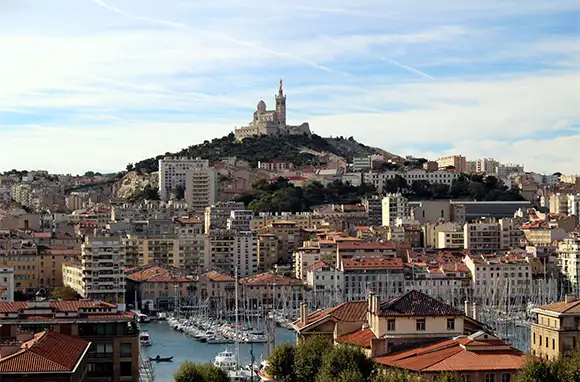
Determined to shed its gritty reputation, sun-kissed Marseille has reinvented itself and shines this year as a European Capital of Culture. With dozens of sleek new museums and artistic venues, the rough-edged Mediterranean port city exudes urban renewal. Some locals even say it’s the new Barcelona. As traditional bouillabaisse simmers in kitchens and the old port bustles with fisherman hauling in their daily catch, a new city emerges.
Marseille’s Capital of Culture year is flying by, and there hasn’t been a better time to visit than now. And continuous updates and events will make this authentic but evolving city an exciting place for years to come.
Image Gallery
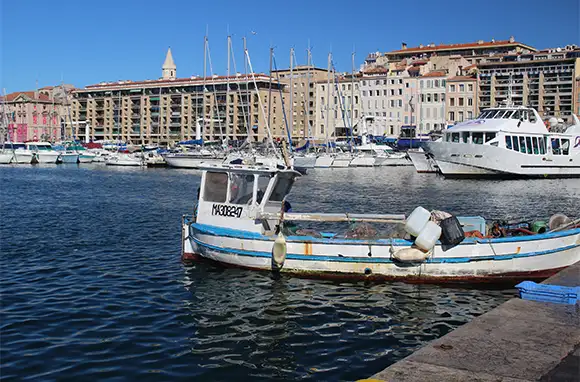
Marseille's Transformation
Approaching Marseille via train offers the expected view of the city, one of graffiti-lined rails and crumbling neighborhood facades. But as you enter its center, particularly Vieux-Port (Old Port), that image quickly changes. Instead of grime and neglect, find pedestrians strolling and socializing, art installations gracing walkways, and civic buildings flying pink banners that read "Welcome, MP2013" (Marseille-Provence 2013). Each year, two European cities or regions that demonstrate a commitment to cultural development are given the title of Capital of Culture. This year, Marseille and the region of Provence took the honor. (The other destination chosen was Kosice, Slovakia.)
The Capital of Culture designation has motivated Marseille, an immigrant city that melds European and North African influences, to clean up both its urban core and reputation. And while it hasn't found a perfect solution (crime in outlying areas is still a problem), this once-seedy commercial port city now offers a host of refreshing attractions for locals and visitors. Anne Chabot of Marseille Provence Greeters describes the transformation. She says, "The city has changed a lot. The Vieux-Port area is now a pleasant place to stroll around. … Local people also had the chance to take part in unforgettable moments in their town, free and open to everyone, like the opening in January. Visitors who came for MP2013 also discovered the surroundings of Marseille, like the Calanques and Provence." However, the city remains divided. She says, "There are now two worlds in Marseille that exist side by side. The old reputation and the new one."

Marseille's Transformation
Approaching Marseille via train offers the expected view of the city, one of graffiti-lined rails and crumbling neighborhood facades. But as you enter its center, particularly Vieux-Port (Old Port), that image quickly changes. Instead of grime and neglect, find pedestrians strolling and socializing, art installations gracing walkways, and civic buildings flying pink banners that read "Welcome, MP2013" (Marseille-Provence 2013). Each year, two European cities or regions that demonstrate a commitment to cultural development are given the title of Capital of Culture. This year, Marseille and the region of Provence took the honor. (The other destination chosen was Kosice, Slovakia.)
The Capital of Culture designation has motivated Marseille, an immigrant city that melds European and North African influences, to clean up both its urban core and reputation. And while it hasn't found a perfect solution (crime in outlying areas is still a problem), this once-seedy commercial port city now offers a host of refreshing attractions for locals and visitors. Anne Chabot of Marseille Provence Greeters describes the transformation. She says, "The city has changed a lot. The Vieux-Port area is now a pleasant place to stroll around. … Local people also had the chance to take part in unforgettable moments in their town, free and open to everyone, like the opening in January. Visitors who came for MP2013 also discovered the surroundings of Marseille, like the Calanques and Provence." However, the city remains divided. She says, "There are now two worlds in Marseille that exist side by side. The old reputation and the new one."
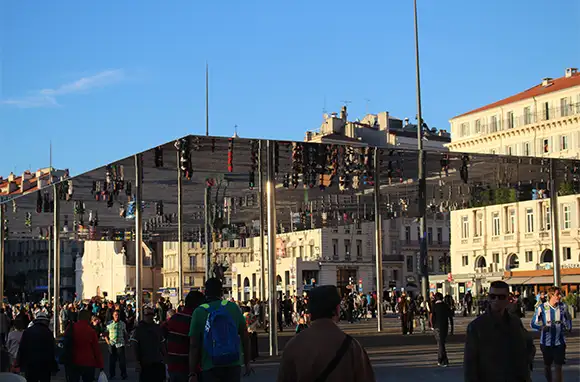
Revitalized Vieux-Port
Buzzing with bars, restaurants, and shops—and serving as a safe harbor for boats and ferries coming and going—Vieux-Port is the beating heart of Marseille. Once congested with traffic, it has received a makeover and is now a relaxed center for people to congregate. With the goal of creating open space, the overhaul project involved reducing lanes for cars while expanding a pedestrian walkway into a grand promenade paved with natural stones that blend seamlessly with the adjacent docks. It's also the setting for the local fish market, which draws chefs who come to select bony rockfish and shellfish for the city's most famous dish, bouillabaisse.
It wouldn't be Capital of Culture without a signature artistic and architectural element anchoring the port's transformation. London-based design firm Foster + Partners was commissioned to create the Ombriere pavilion (pictured), a giant mirrored sunshade that provides people with shelter from the elements as they wait for boats or buses. In a region that claims 300 days of sunshine per year, the installation is a practicality. However, the simple structure also dazzles with beauty. Supported by eight skinny, unobtrusive poles, the polished stainless steel shimmers while reflecting the water's edge, the sky, and the people gathering below without hindering the view of the idyllic harbor.
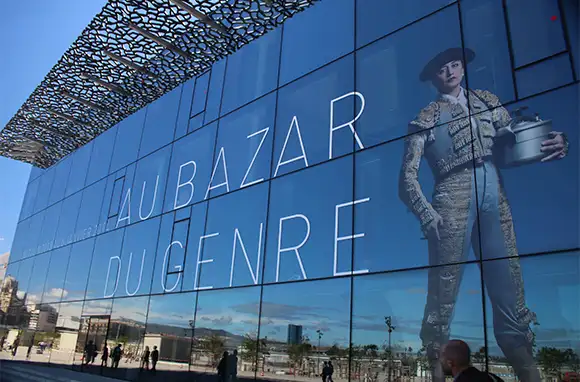
MuCEM and Other New Venues
Suspended outdoor footbridges connecting 12th-century Fort Saint-Jean and the stunning new glass-encased J4 building on a former pier send museum-goers on a pilgrimage between old Marseille and the sea, at least metaphorically. Together, these two buildings (plus a third at a separate location) make up the city's new flagship cultural venue, Musee des Civilisations de l'Europe et de la Mediterranee, a mouthful of a name that can be distilled to simply "MuCEM." Opened in June, the MuCEM focuses loosely on the culture of the Mediterranean (and Europe) and is France's first national museum outside of Paris. The collection, concentrated in J4's Galerie de la Mediterranee, includes artifacts from antiquity as well as multimedia displays bridging contemporary cultural expressions.
Other key venues built or renovated for Capital of Culture include Villa Mediterranee, an exhibition center next to the MuCEM that appears to float on water; Tour-Panorama, dedicated to contemporary art; and the J1 Hangar, used for hosting special events. Visit the MP2013 website for a full list.
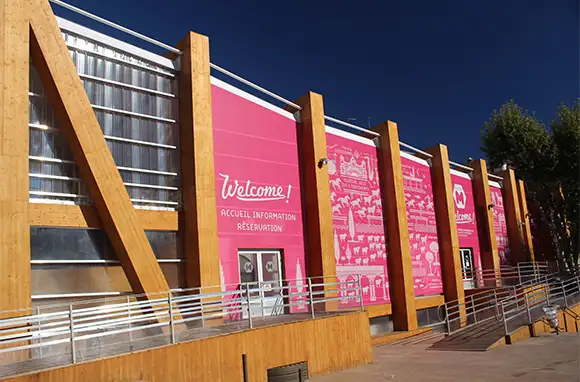
Capital of Culture Events and Installations
M is for Marseille. And for those coming to experience Capital of Culture, Pavillon M in Espace Villeneuve Bargemon is the best starting point. The temporary but sustainable structure, which will be completely recycled when it closes in December, functions as an information center for the hundreds of special events taking place in and around the city.
The robust Marseille-Provence cultural program focuses on artistic excellence in Europe and the Mediterranean Basin and has been divided into three parts for the year. Part 1, "Welcoming the World," (from January through May) served as an opening ceremony with inaugural festivities, while Part 2, "Open Sky," (from June through September) celebrated the outdoors with major events like TransHumance, an artistic procession of animals (including flocks of sheep and herds of horses) and humans from Italy and Provence. While only Part 3, "Land of a Thousand Faces," (from September through December) remains, some of the best was saved for last, with highlights centering on the region's emblematic personalities (including Albert Camus and Le Corbusier), local cuisine, and new technologies and innovations as they apply to art. Also, in November, famous Paris museum Centre Pompidou will deliver part of its permanent collection to be showcased on the banks of the Huveaune River in Aubagne (just outside Marseille) through January 2014.
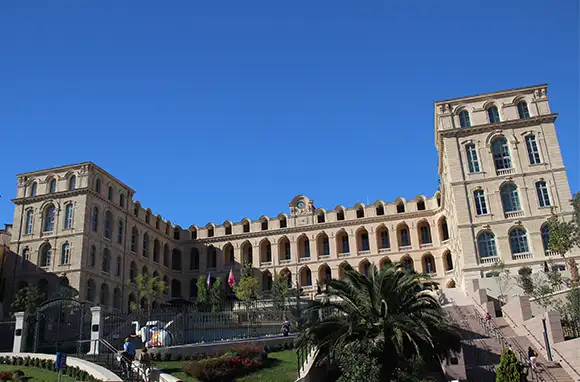
InterContinental Hotel Dieu
The brand-new 194-room InterContinental Hotel Dieu brings pure grandeur to Marseille just in time for the peak of Capital of Culture. Opened in May, the five-star property was transformed over the course of many years from its former life as a centuries-old hospital. Now, it takes care of people in a different way: though pampered luxury, with spacious guestrooms and the full-service Spa by Clarins. Its restored facade maintains the building's original integrity, while Jean-Philippe Nuel's contemporary interior design imbues the hotel with what reps refer to as a subdued "mineral" atmosphere, a nod to Marseille's surrounding environment. (For example, a grand picture frame made up of hundreds of local mussels adorns the lobby.) Careful attention was also devoted to preserving the building's old bones, including intricate wrought-iron staircases and a fragment of a 12th-century Roman mosaic uncovered during excavation.
If a night's stay is out of your budget, come by for lunch or kick back on the marvelous terrace while sipping a glass of rosé or an anise-flavored pastis aperitif, all while taking in the perfectly centered view of the Notre Dame de la Garde basilica high up on its hilltop.
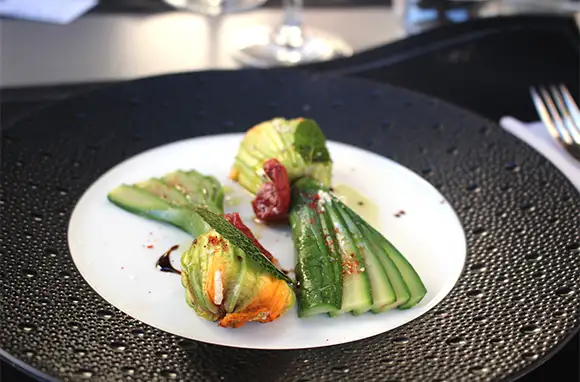
Marseillais Cuisine
Through a combination of restaurants new and old, street food, and special gastronomic events, Marseillais cuisine highlights the region's culture in the most sensory way. At the InterContinental's brasserie, Les Fenetres, top chef Lionel Lévy uses local Provencal flavors to create modern dishes, such as stuffed zucchini blossoms with pistou (pictured) and a savory deconstructed bouillabaisse "milkshake." (Though it's hard to imagine Lévy's food could get any more refined, his gourmet restaurant, Alcyone, opens in the fall.) For traditionalists, institutions like Le Miramar along the Old Port still serve the seafood stew the old way, in two separate dishes: one, a soup served with a rich rouille (an aioli with olive oil and saffron) spread over garlic-rubbed croutons, and the other, a vibrant heap of fish and crustaceans that can be mixed into the broth or eaten separately.
While few official food-focused Capital of Culture events remain, the Gourmediterranee association, set up in 2012, promotes regional food and continues to provide unique opportunities to sample it.
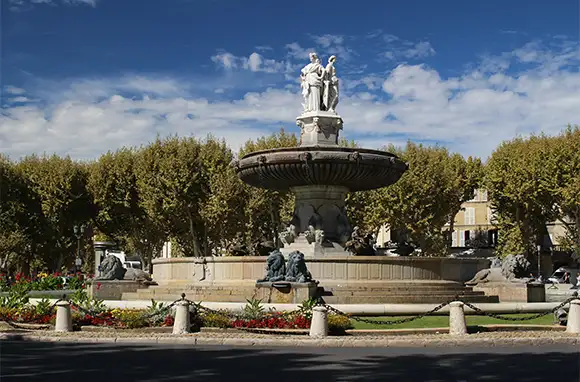
Beyond Marseille
Capital of Culture isn't limited to the city of Marseille but extends to other destinations in Provence's Bouches-du-Rhone department. From the ancient World Heritage city of Arles to ever-chic Aix-en-Provence (and nearly every village in between), events and new institutions blanket the region.
No stranger to art (mainly thanks to a prolific stint in town by Vincent van Gogh), Arles plays host to several major events, including an exhibit on fashion designer Christian Lacroix at the Abbey of Montmajour, and Nuages, an exhibition at Musee Reattu, with works dedicated to clouds by more than 40 artists. Opened in September in fine arts hub Aix-en-Provence, Darius Milhaud Conservatory is dedicated to teaching music, dance, and theater, while other new additions to the city include the Centre International des Arts en Mouvement and Chapelle des Penitents Blancs, part of an expansion of the Musee Granet (which will present "From Cezanne to Matisse" through November 10).
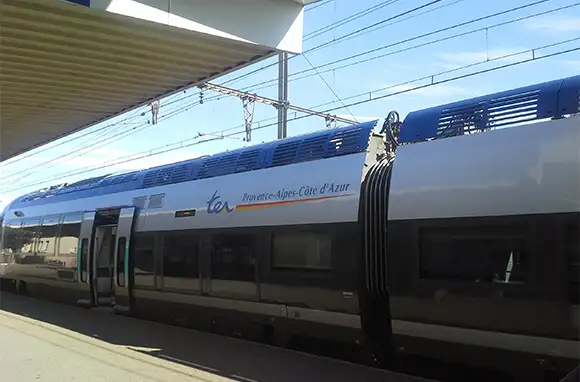
Getting to Marseille-Provence
Getting to the Bouches-du-Rhone region is relatively easy. Fly into Paris, then take the high-speed TGV train connecting Paris to Aix-en-Provence or Marseille in about three hours; book with Rail Europe, which provides customer service in English and periodically offers deals. Air France and airline partner Delta run regular flights to Paris from many U.S. gateways, and French airline XL Airways provides nonstop seasonal air service from New York; a recent search turned up fares for €485 (about $659) round-trip for October flights.
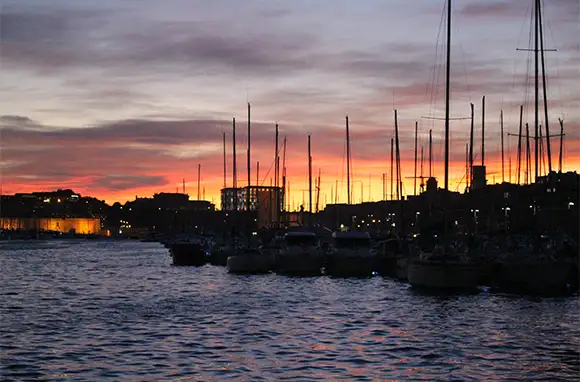
What's Next for Marseille?
While it might be the oldest city in France, Marseille is centered on all that's new. With an investment of more than 660 million euros, the development around Marseille-Provence Capital of Culture has raised the region's profile as an attractive destination. And the improvements continue, particularly around EuroMediterranee, Marseille's urban-renewal project focused on revitalizing the city center and waterfront. Also expect new commercial centers—with restaurants, bars, and gourmet-food markets—such as Les Voutes de la Major and Les Terrasses du Port; the renovation and expansion of the Velodrome football stadium; and a project geared around adding green spaces to Vieux-Port by 2020.
With all these changes afoot, one question remains: How will Marseille's transformation end? The answer, like the strong mistral wind that sweeps through the region, is unpredictable. Anything is possible. The only certainty is that the Capital of Culture spirit will live on and that Marseille will continue to draw visitors for many years to come.
You Might Also Like:
We hand-pick everything we recommend and select items through testing and reviews. Some products are sent to us free of charge with no incentive to offer a favorable review. We offer our unbiased opinions and do not accept compensation to review products. All items are in stock and prices are accurate at the time of publication. If you buy something through our links, we may earn a commission.
Top Fares From
Today's Top Travel Deals
Brought to you by ShermansTravel
Kenya: 14-Night Tour, Incl. Tanzania &...
smarTours
 vacation
$7125+
vacation
$7125+
7-Night Caribbean Round-Trip Cruise From Orlando:...
Norwegian Cruise Line
 cruise
$739+
cruise
$739+
Ohio: Daily Car Rentals from Cincinnati
85OFF.com
 Car Rental
$19+
Car Rental
$19+



